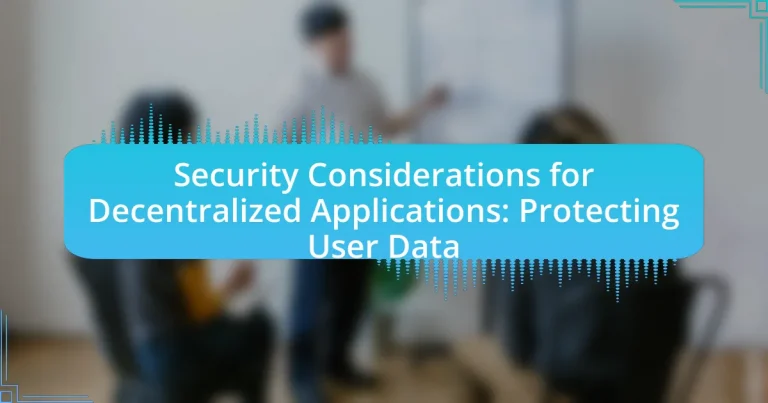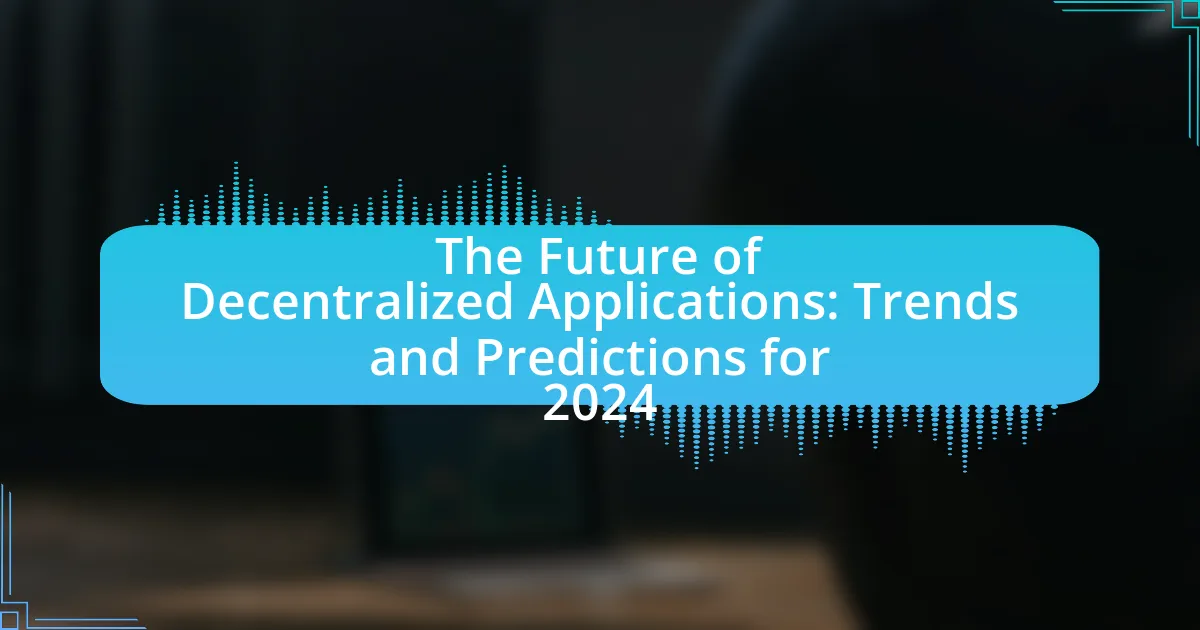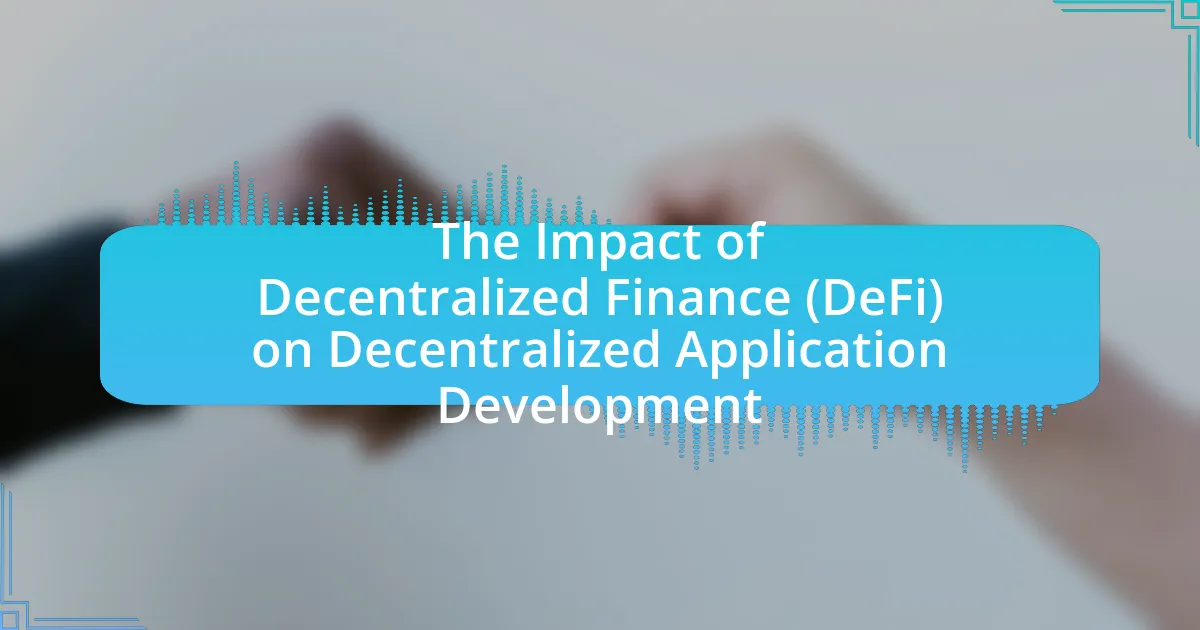The article focuses on key security considerations for decentralized applications (dApps), emphasizing the importance of protecting user data. It outlines critical aspects such as data privacy, smart contract vulnerabilities, and network security, highlighting unique risks like phishing attacks and malware. The discussion includes best practices for securing user data, the role of encryption, and the impact of regulatory compliance on dApps. Additionally, it addresses the significance of community auditing and regular security audits in enhancing application safety, ultimately underscoring the necessity for robust security measures in the development and deployment of decentralized applications.
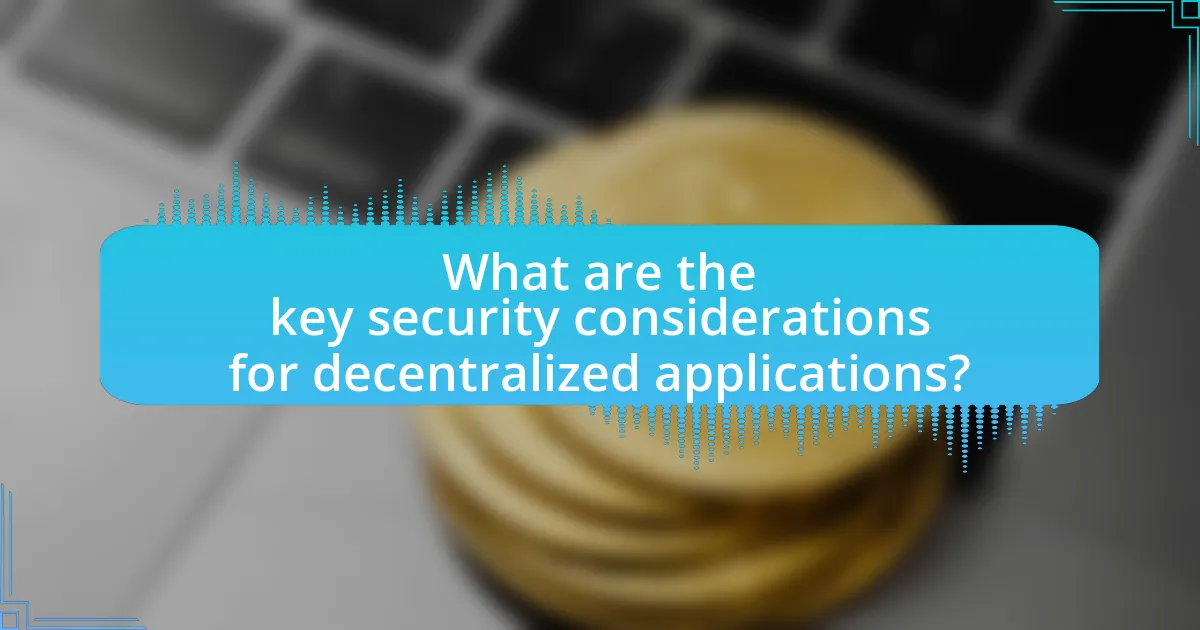
What are the key security considerations for decentralized applications?
Key security considerations for decentralized applications include data privacy, smart contract vulnerabilities, and network security. Data privacy is crucial as decentralized applications often handle sensitive user information; thus, implementing strong encryption and user consent mechanisms is essential. Smart contract vulnerabilities can lead to significant financial losses, as evidenced by the DAO hack in 2016, where a flaw in the smart contract allowed attackers to siphon off $60 million in Ether. Network security is also vital, as decentralized applications rely on peer-to-peer networks that can be susceptible to Distributed Denial of Service (DDoS) attacks, which can disrupt service availability. These considerations highlight the importance of robust security measures in the development and deployment of decentralized applications.
How do decentralized applications differ from traditional applications in terms of security?
Decentralized applications (dApps) differ from traditional applications in terms of security primarily due to their reliance on blockchain technology, which enhances data integrity and reduces single points of failure. In dApps, data is distributed across a network of nodes, making it more resilient to attacks such as data breaches and server failures that commonly affect centralized systems. For instance, a study by the Cambridge Centre for Alternative Finance highlights that blockchain’s cryptographic techniques provide a higher level of security for user data compared to conventional databases, which are often vulnerable to hacking. Additionally, dApps typically utilize smart contracts that execute automatically under predefined conditions, minimizing human error and potential security loopholes present in traditional applications.
What unique vulnerabilities do decentralized applications face?
Decentralized applications (dApps) face unique vulnerabilities such as smart contract bugs, lack of regulatory oversight, and susceptibility to Sybil attacks. Smart contract bugs can lead to significant financial losses, as evidenced by the DAO hack in 2016, where vulnerabilities in the smart contract code allowed attackers to drain $60 million worth of Ether. The absence of regulatory frameworks means that users have limited recourse in the event of fraud or exploitation. Additionally, Sybil attacks, where a single entity creates multiple identities to gain control over a network, can undermine the integrity of decentralized systems, as seen in various blockchain networks. These vulnerabilities highlight the need for robust security measures in the development and deployment of dApps.
How does the lack of central authority impact security measures?
The lack of central authority significantly weakens security measures by decentralizing control and increasing vulnerability to attacks. In decentralized systems, the absence of a single governing body means that there is no unified protocol for enforcing security standards, leading to inconsistencies in how data is protected. For instance, without a central authority, individual nodes may implement varying security practices, which can create gaps that malicious actors can exploit. Research indicates that decentralized applications are more susceptible to attacks such as Sybil attacks and Distributed Denial of Service (DDoS) due to this fragmentation of security oversight. Consequently, the lack of a central authority can lead to a higher risk of data breaches and compromised user information.
Why is protecting user data critical in decentralized applications?
Protecting user data is critical in decentralized applications because it ensures user privacy and security against unauthorized access. In decentralized systems, data is often stored across multiple nodes, making it susceptible to breaches if not properly secured. According to a report by the World Economic Forum, 70% of consumers express concern about data privacy, highlighting the importance of safeguarding personal information to maintain user trust. Furthermore, breaches can lead to identity theft and financial loss, which can undermine the entire ecosystem of decentralized applications. Therefore, robust data protection measures are essential to uphold user confidence and the integrity of decentralized networks.
What types of user data are most at risk in decentralized applications?
User data most at risk in decentralized applications includes personal identification information, financial data, and transaction history. These types of data are vulnerable due to the lack of centralized control and oversight, which can lead to exposure through smart contract vulnerabilities or inadequate encryption methods. For instance, a study by the European Union Agency for Cybersecurity (ENISA) highlights that decentralized applications often lack robust security measures, making sensitive data susceptible to breaches and unauthorized access.
How can data breaches affect user trust and application adoption?
Data breaches significantly undermine user trust and hinder application adoption. When users learn that their personal information has been compromised, they often feel vulnerable and question the security measures of the application. According to a 2020 study by IBM, 80% of consumers would stop using a service if they experienced a data breach. This loss of trust can lead to decreased user engagement and a reluctance to adopt new applications, particularly in decentralized environments where security is paramount. Furthermore, the reputational damage to the application can result in long-term financial consequences, as users gravitate towards competitors perceived as more secure.
What are the best practices for securing user data in decentralized applications?
The best practices for securing user data in decentralized applications include implementing strong encryption, utilizing decentralized identity solutions, and ensuring regular security audits. Strong encryption protects data both at rest and in transit, making it unreadable to unauthorized parties. Decentralized identity solutions, such as self-sovereign identity frameworks, empower users to control their personal information, reducing the risk of data breaches. Regular security audits help identify vulnerabilities and ensure compliance with security standards, thereby enhancing the overall security posture of the application. These practices are essential for maintaining user trust and safeguarding sensitive information in decentralized environments.
How can encryption be effectively utilized in decentralized applications?
Encryption can be effectively utilized in decentralized applications by ensuring data confidentiality, integrity, and authenticity through cryptographic techniques. These applications can implement end-to-end encryption to protect user data during transmission, preventing unauthorized access and ensuring that only intended recipients can decrypt the information. Additionally, decentralized applications can use public-key cryptography to authenticate users and secure transactions, as seen in blockchain technologies where cryptographic signatures validate the identity of participants. This approach not only enhances security but also fosters user trust, as it mitigates risks associated with data breaches and unauthorized data manipulation.
What role do smart contracts play in enhancing security?
Smart contracts enhance security by automating and enforcing agreements without the need for intermediaries. This automation reduces the risk of human error and fraud, as the terms of the contract are executed exactly as programmed. Additionally, smart contracts operate on blockchain technology, which provides a decentralized and immutable ledger, making it difficult for malicious actors to alter contract terms or manipulate data. The transparency of blockchain allows all parties to verify the contract’s execution, further ensuring trust and security in transactions.
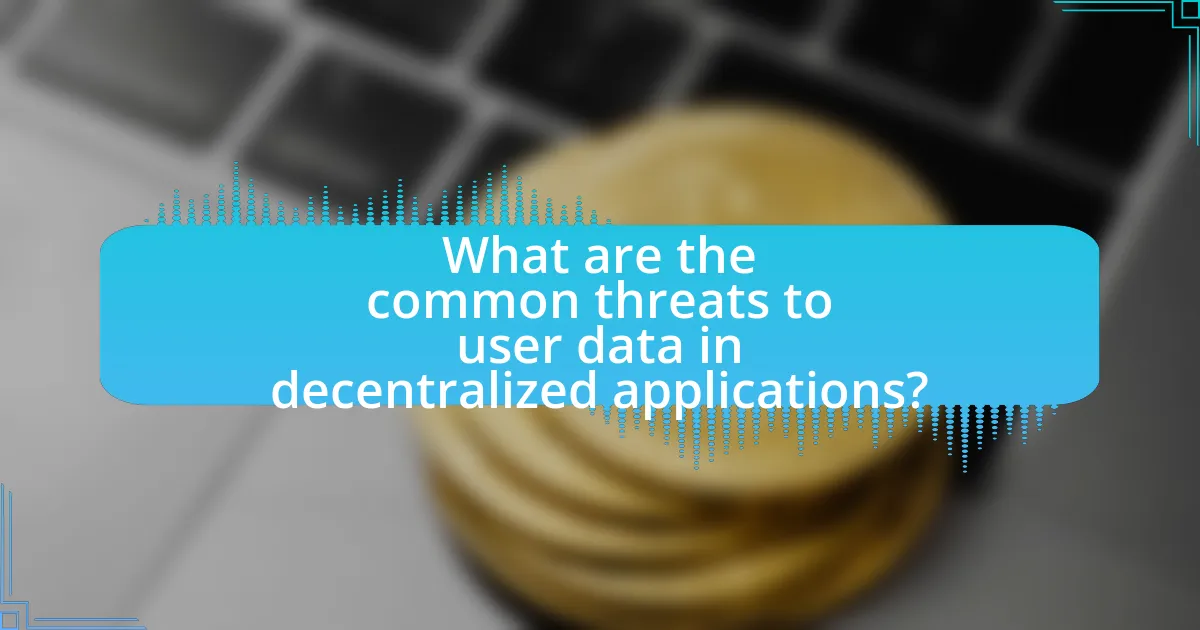
What are the common threats to user data in decentralized applications?
Common threats to user data in decentralized applications include data breaches, smart contract vulnerabilities, and phishing attacks. Data breaches can occur due to inadequate security measures, exposing sensitive information. Smart contract vulnerabilities arise from coding errors or flaws, which can be exploited by attackers to manipulate or steal assets. Phishing attacks target users through deceptive communications, tricking them into revealing private keys or credentials. According to a report by the Blockchain Security Alliance, over 50% of decentralized applications have experienced at least one security incident, highlighting the prevalence of these threats.
How do phishing attacks target users of decentralized applications?
Phishing attacks target users of decentralized applications by impersonating legitimate services to steal sensitive information, such as private keys or login credentials. Attackers often create fake websites or applications that closely resemble the original decentralized application, tricking users into entering their information. For instance, a study by the Anti-Phishing Working Group reported that in 2021, phishing attacks increased by 22% compared to the previous year, highlighting the growing threat to users of various online platforms, including decentralized applications. Additionally, social engineering tactics are frequently employed, where attackers manipulate users into revealing personal information through deceptive communications, further compromising user security.
What measures can users take to protect themselves from phishing?
Users can protect themselves from phishing by implementing several key measures. First, they should verify the authenticity of emails and messages by checking the sender’s address and looking for signs of spoofing, such as misspellings or unusual domains. Additionally, users should avoid clicking on links or downloading attachments from unknown sources, as these are common tactics used in phishing attacks.
Using multi-factor authentication (MFA) adds an extra layer of security, making it more difficult for attackers to gain access to accounts even if login credentials are compromised. Regularly updating passwords and using strong, unique passwords for different accounts further enhances security.
Moreover, users should educate themselves about common phishing techniques and stay informed about the latest threats. According to the Anti-Phishing Working Group, there were over 1.2 million phishing attacks reported in 2020, highlighting the importance of vigilance and proactive measures in protecting personal information.
How can developers mitigate the risk of phishing attacks?
Developers can mitigate the risk of phishing attacks by implementing multi-factor authentication (MFA) for user accounts. MFA significantly reduces the likelihood of unauthorized access, as it requires users to provide two or more verification factors, making it harder for attackers to compromise accounts. According to a study by Google, MFA can block 99.9% of automated attacks, demonstrating its effectiveness in enhancing security. Additionally, developers should educate users about recognizing phishing attempts and encourage the use of password managers to create and store complex passwords securely. These strategies collectively strengthen defenses against phishing threats.
What is the impact of malware on decentralized applications?
Malware significantly undermines the security and functionality of decentralized applications (dApps) by compromising user data and disrupting operations. When malware infiltrates a dApp, it can lead to unauthorized access to sensitive information, manipulation of smart contracts, and loss of user funds. For instance, a study by the European Union Agency for Cybersecurity (ENISA) highlights that malware attacks on blockchain networks can exploit vulnerabilities in dApps, resulting in financial losses exceeding millions of dollars. Additionally, malware can facilitate phishing attacks, where users are tricked into revealing private keys or credentials, further jeopardizing the integrity of decentralized systems.
How can malware compromise user data in decentralized environments?
Malware can compromise user data in decentralized environments by exploiting vulnerabilities in the software or protocols used for data transmission and storage. For instance, malware can intercept communications between nodes, allowing attackers to capture sensitive information such as private keys or personal data. Additionally, decentralized applications may lack robust security measures, making them susceptible to attacks like phishing or social engineering, where users are tricked into revealing their credentials. Research indicates that decentralized systems often have weaker security postures compared to centralized systems, as they rely on the collective security of individual nodes, which may not be uniformly maintained. This disparity can lead to increased risks of data breaches and unauthorized access to user information.
What strategies can be implemented to prevent malware attacks?
To prevent malware attacks, organizations should implement a multi-layered security approach that includes regular software updates, robust antivirus solutions, user education, and network security measures. Regularly updating software ensures that vulnerabilities are patched, reducing the risk of exploitation; for instance, a report by the Cybersecurity and Infrastructure Security Agency (CISA) highlights that 85% of successful cyberattacks exploit known vulnerabilities that could have been mitigated through timely updates. Utilizing reputable antivirus software provides real-time protection against malware threats, while educating users about phishing and safe browsing practices significantly lowers the likelihood of human error leading to malware infections. Additionally, employing firewalls and intrusion detection systems can help monitor and control incoming and outgoing network traffic, further safeguarding against potential malware attacks.
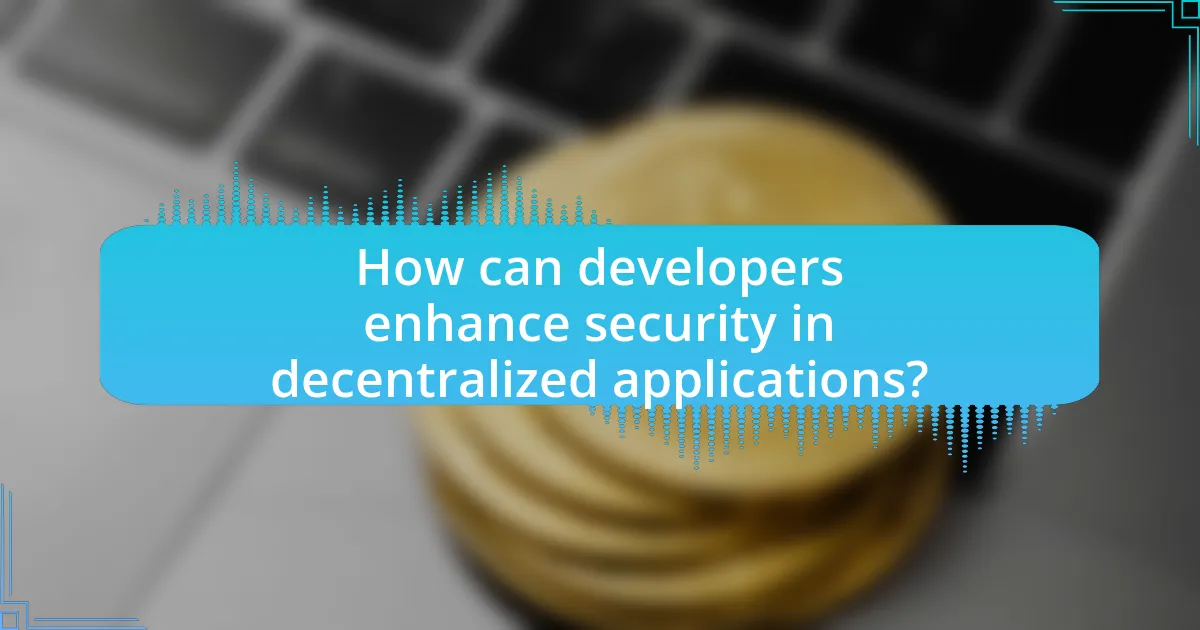
How can developers enhance security in decentralized applications?
Developers can enhance security in decentralized applications by implementing robust cryptographic techniques and conducting thorough security audits. Cryptographic methods, such as end-to-end encryption and secure key management, protect user data from unauthorized access and ensure data integrity. Additionally, regular security audits help identify vulnerabilities and weaknesses in the application’s code and architecture, allowing developers to address potential threats proactively. According to a study by the European Union Agency for Cybersecurity, 95% of security breaches are due to human error, emphasizing the importance of continuous education and training for developers on security best practices.
What tools and frameworks are available for securing decentralized applications?
Tools and frameworks available for securing decentralized applications include OpenZeppelin, Truffle, and ConsenSys Diligence. OpenZeppelin provides a library of secure smart contracts and tools for auditing, ensuring that developers can implement best practices in security. Truffle offers a development environment and testing framework that includes built-in security features for smart contracts. ConsenSys Diligence focuses on security audits and tools like MythX, which analyzes smart contracts for vulnerabilities. These tools are widely recognized in the blockchain community for enhancing the security of decentralized applications.
How do these tools help in identifying vulnerabilities?
These tools assist in identifying vulnerabilities by systematically scanning applications for security flaws and weaknesses. They employ techniques such as static and dynamic analysis, which evaluate code and runtime behavior, respectively, to uncover potential entry points for attacks. For instance, tools like OWASP ZAP and Burp Suite can detect common vulnerabilities such as SQL injection and cross-site scripting by analyzing application responses to various inputs. This capability is supported by extensive databases of known vulnerabilities, allowing these tools to provide accurate assessments based on established security standards.
What role does community auditing play in application security?
Community auditing plays a critical role in application security by leveraging collective expertise to identify vulnerabilities and improve code quality. This collaborative approach allows developers and users to scrutinize the application, leading to the discovery of security flaws that may not be evident to a single developer or team. For instance, community-driven projects often benefit from diverse perspectives, which can enhance the robustness of security measures. Research indicates that open-source projects with active community involvement tend to have fewer security vulnerabilities, as evidenced by a study published in the “Journal of Cybersecurity” that found a 30% reduction in vulnerabilities in projects with regular community audits compared to those without.
What are the regulatory considerations for securing user data?
Regulatory considerations for securing user data include compliance with laws such as the General Data Protection Regulation (GDPR) in Europe, the California Consumer Privacy Act (CCPA) in the United States, and various sector-specific regulations. These regulations mandate that organizations implement appropriate technical and organizational measures to protect personal data, ensure transparency in data processing, and uphold user rights regarding data access and deletion. For instance, GDPR requires data protection by design and by default, compelling organizations to integrate data security measures into their systems from the outset. Non-compliance can result in significant fines, as seen with GDPR penalties reaching up to 4% of annual global turnover or €20 million, whichever is higher.
How do data protection laws affect decentralized applications?
Data protection laws significantly impact decentralized applications by imposing requirements for user data handling and privacy. These laws, such as the General Data Protection Regulation (GDPR) in the European Union, mandate that organizations ensure data protection rights, including consent, data access, and the right to be forgotten. Decentralized applications, which often lack a central authority, face challenges in complying with these regulations, as they may not have a clear entity responsible for data management. For instance, under GDPR, failure to comply can result in fines up to 4% of annual global turnover or €20 million, whichever is higher, emphasizing the need for decentralized applications to implement robust data governance frameworks to avoid legal repercussions.
What compliance measures should developers be aware of?
Developers should be aware of compliance measures such as GDPR, CCPA, and HIPAA, which govern data protection and privacy. GDPR mandates that developers implement data protection by design and by default, ensuring user consent and the right to access personal data. CCPA requires transparency about data collection practices and gives users the right to opt-out of data selling. HIPAA imposes strict regulations on handling health information, necessitating secure data storage and transmission. These regulations are crucial for protecting user data and avoiding legal penalties, as non-compliance can result in fines reaching millions of dollars.
What practical steps can developers take to secure user data in decentralized applications?
Developers can secure user data in decentralized applications by implementing strong encryption methods for data at rest and in transit. Utilizing end-to-end encryption ensures that only authorized users can access sensitive information, thereby protecting it from unauthorized access. Additionally, developers should adopt decentralized identity solutions, such as self-sovereign identity frameworks, which allow users to control their personal data without relying on a central authority. Regular security audits and vulnerability assessments are also crucial, as they help identify and mitigate potential security risks. Furthermore, employing smart contract best practices, including thorough testing and formal verification, can prevent exploits and ensure the integrity of the application. These steps collectively enhance the security posture of decentralized applications, safeguarding user data effectively.
How can regular security audits improve application safety?
Regular security audits enhance application safety by identifying vulnerabilities and ensuring compliance with security standards. These audits systematically evaluate the application’s code, architecture, and configurations, revealing weaknesses that could be exploited by attackers. For instance, a study by the Ponemon Institute found that organizations conducting regular security audits reduced their risk of data breaches by 30%. By addressing identified issues promptly, organizations can fortify their applications against potential threats, thereby protecting user data more effectively.
What are the best practices for user education on security risks?
The best practices for user education on security risks include providing clear and concise information about potential threats, implementing regular training sessions, and utilizing real-world examples to illustrate risks. Clear communication helps users understand specific threats such as phishing, malware, and social engineering. Regular training sessions, ideally quarterly, reinforce knowledge and keep users updated on evolving threats. Real-world examples, such as case studies of security breaches, demonstrate the consequences of inadequate security practices, making the information more relatable and impactful. According to a study by the Ponemon Institute, organizations that invest in security awareness training can reduce the likelihood of a successful attack by up to 70%.












